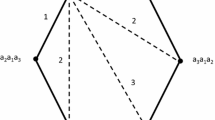Abstract
It is shown that the representative capacity of democratic institutions selected by lot (=lottery), as it has been practiced in Athens in 594–322BC, is quite high. For this purpose, People’s Assembly, Council of 500, Committee of 50 with its President, juries, and magistrates are evaluated with indicators of popularity, universality, and goodness. The popularity is a spatial characteristic of representativeness, the average percentage of the population whose opinion is represented on a number of questions. The universality is a temporal aspect of representativeness, the frequency of cases (percentage of questions) when the opinion of a majority is represented. The goodness is the specific representativeness, that is, the average group-represented- to-majority ratio. In particular, it is shown that the size of Athenian representative bodies selected by lot was adequate to guarantee their high representativeness. The background idea is the same as in Gallup polls of public opinion and in quality control based on limited random samples.
Similar content being viewed by others
References
Abramowitz M and Stegun I (1972). Handbook of mathematical functions. Dover, New York
Achen Ch (1977). Measuring representation: Perils of the correlation coefficient. Am J Polit Sci 21(4): 805–815
Aristotle (1984). The constitution of Athens. Penguin, Harmondsworth
Arrow KJ (1951). Social choice and individual values. Wiley, New York
Black D (1958). The theory of committees and elections. At the University Press, Cambridge
Blackwell ChW (2003a) Ephialtes. In: Demos. Classical Athenian Democracy. http://doxa.stoa.org/cocoon/demos/home
Blackwell ChW (2003b) Cimon. In: Demos. Classical Athenian Democracy. http://doxa.stoa.org/cocoon/demos/home
Brams SJ, Kilgour DM and Zwicker WS (1998). The paradox of multiple elections. Soc Choice Welf 15: 211–236
Décision no 85–192 DC du 24 juillet (1985) Loi portant diverses dispositions d’ordre social. http://www.conseil-constitutionnel.fr/decision/1985/85192dc.htm
Hansen MH (1986). The origin of the word demokratia. Liverpool Classical Monthly 11: 35–36
Hansen MH (1990). When was selection by lot of magistrates introduced in Athens. Classica Medievalia 41: 51–54
Hansen MH (1991). The Athenian democracy in the age of demosthenes: structure, principles and ideology. Blackwell, Oxford
Headlam JW (1933). Election by lot at Athens. Cambridge University Press, Cambridge
Held D (1996). Models of democracy, 2nd edn. Polity Press, Cambridge
Manin B (1997). The principes of representative government. Cambridge University Press, Cambridge
Miller NR (1983). Pluralism and social choice. Am Polit Sci Rev 77: 734–747
Pitkin H (1967). The concept of representation. University of California Press, Berkeley
Pocock JG (1975). The Machiavellian moment: florentine political thought and the Atlantic Republican tradition. Princeton University Press, Princeton
Tangian (Tanguiane) A (1991). Aggregation and representation of preferences. Springer, Berlin
Tangian (Tanguiane) A (1993). Inefficiency of democratic decision making in an unstable society. Soc Choice Welf 10(3): 249–300
Tangian (Tanguiane) A (1994). Arrow’s paradox and mathematical theory of democracy. Soc Choice Welf 11(1): 1–82
Tangian A (1997). An outline of the mathematical theory of democracy and its applications. Group Decis Negotiation 6(3): 205–230
Tangian A (2006) German parliamentary elections 2005: results in the mirror of party manifestos. WSI Diskussionspapier 139E, Hans Böckler Stiftung, Düsseldorf. http://www.boeckler.de/pdf/p_wsi_diskp_139_e.pdf
Tangian AS (2007). Selecting predictors for traffic control by methods of the mathematical theory of democracy. Eur J Oper Res 181: 986–1003
Tangian AS (2008). Predicting DAX trends from Dow Jones data by methods of the mathematical theory of democracy. Eur J Oper Res 185: 1632–1662
Author information
Authors and Affiliations
Corresponding author
Rights and permissions
About this article
Cite this article
Tangian, A. A mathematical model of Athenian democracy. Soc Choice Welfare 31, 537–572 (2008). https://doi.org/10.1007/s00355-008-0295-y
Received:
Accepted:
Published:
Issue Date:
DOI: https://doi.org/10.1007/s00355-008-0295-y




